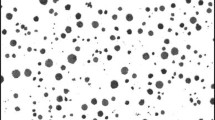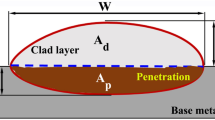Abstract
Ductile iron has comprehensive properties that are similar to steel, making it is widely used for core components in key equipment such as the automotive engine crankshafts, machine tool beds, cylinder liners, and brake levers. However, the material has inherent structural defects such as the cracks, shrinkage, and subcutaneous porosity, which can easily lead to parts failure due to fracture, wear, and corrosion. Therefore, it is significant to repair and strengthen the surface for ductile iron. Laser cladding has several advantages, including low thermal deformation and high bond strength, which provides an effective method for repairing and strengthening ductile iron parts. For parts with serious area damage, a single-track cladding cannot meet the requirements for use, multi-track overlapping and multilayer cladding processes are typically used for repair and strengthening. Nickel-based and cobalt-based alloys are often utilized to reinforce the surface of core parts due to high-temperature resistance, oxidation resistance, and low deformation. The Co12 lattice structure is susceptible to thermal transformation, which can cause cracking for the cladding layer, making it is primarily used as a top cladding material. In this study, IN625 powder was used as the base of multilayer cladding, followed by Co12 powder. The hardness, wear resistance, corrosion resistance, and other properties for cladding layer were analyzed. The results show that the multi-track overlapping process has a high metallurgical bonding effect, and the grain in the lap remelting area is refined. Through multilayer cladding, the overall hardness for the ductile iron exceeds 500 HV, and the mechanical properties are significantly improved. The corrosion rate reduces by 395.5 times, and the corrosion resistance is improved.














Similar content being viewed by others
Data availability
The authors confirm that the data supporting the findings of this study are available within the article.
References
Y. Li, S. Dong, X. Liu et al., Interface Phase Evolution During Laser Cladding of Ni-Cu Alloy on Nodular Cast Iron by Powder Pre-placed Method, Opt. Laser Technol., 2021, 135, p 106684.
T. Andriollo, Y. Zhang, S. Fæster et al., Analysis of the Correlation between Micro-mechanical Fields and Fatigue Crack Propagation Path in Nodular Cast Iron, Acta Mater., 2020, 188, p 302–314.
Y. Li, S. Dong, P. He et al., Microstructure Characteristics and Mechanical Properties of New-Type FeNiCr Laser Cladding Alloy Coating on Nodular Cast Iron, J. Mater. Process. Technol., 2019, 269, p 163–171.
K. Zhan, Y. Zhang, L. Bao et al., Surface Characteristic and Wear Resistance of QT-700-2 Nodular Cast Iron after Laser Quenching Combing with Shot Peening Treatment, Surf. Coat. Technol., 2021, 423, p 127589.
Y. Takemoto, M. Mizumoto, and K. Kinno, Internal Porosity Defects in Ductile Cast Irons, Int. J. Metalcast., 2021, 15, p 916–929.
M. Endo and K. Yanase, Effects of Small Defects, Matrix Structures and Loading Conditions on the Fatigue Strength of Ductile Cast Irons, Theoret. Appl. Fract. Mech., 2014, 69, p 34–43.
E. Marques, F. Silva, O.C. Paiva et al., Improving the Mechanical Strength of Ductile Cast Iron Welded Joints Using Different Heat Treatments, Materials, 2019, 12(14), p 2263.
R.A. Jeshvaghani, E. Harati, and M. Shamanian, Effects of Surface Alloying on Microstructure and Wear Behavior of Ductile Iron Surface-Modified with a Nickel-Based Alloy Using Shielded Metal Arc Welding, Mater. Des., 2011, 32(3), p 1531–1536.
Y. Yao, Study on Process and Microstructure of Plasma Spraying Coating Nickel 60 on Nodular Cast Iron, Hot Work. Technol., 2013, 42(24), p 175–176.
L. Hao, G. Lu, and C. Liu, State of Residual Stress and Numerical Analysis of TGO in Plasma Sprayed 8YSZ Thermal Barrier Coating on QT500, Rare Metal Mater. Eng., 2015, 44(04), p 1024–1029.
D. Wei, M. Yafeng et al., Investigation on Morphology and Micro-hardness Characteristic of Composite Coatings Reinforced by PTA Copper Alloying on Nodular Cast Iron, J. Alloys Compd., 2016, 689, p 680–692.
Y. Li, S. Dong, S. Yan et al., Phase Evolution of Ductile Iron during Laser Cladding Processing, Surf. Coat. Technol., 2018, 339, p 37–47.
N. Jeyaprakash, C.H. Yang, M. Duraiselvam et al., Microstructure and Tribological Evolution during Laser Alloying WC-12% Co and Cr3C2−25% NiCr Powders on Nodular Iron Surface, Results Phys., 2019, 12, p 1610–1620.
Y. Li, S. Dong, X. Liu et al., Interface Phase Evolution During Laser Cladding of Ni-Cu Alloy on Nodular Cast Iron by Powder Pre-placed Method, Opt. Laser Technol., 2021, 135(3), p 106684.
Y. Cao, N. Farouk, M. Taheri et al., Evolution of Solidification and Microstructure in Laser-Clad IN625 Superalloy Powder on GTD-111 Superalloy, Surf. Coat. Technol., 2021, 412, p 127010.
L. Chen, X. Zhang, Y. Wu et al., Effect of Surface Morphology and Microstructure on the Hot Corrosion Behavior of TiC/IN625 Coatings Prepared by Extreme High-Speed Laser Cladding, Corros. Sci., 2022, 201, p 110271.
C. Li, Yu. Zhibin, J. Gao et al., Multi-field Coupling Simulation and Experiment of Laser Cladding under Thermal Dependent Physical Properties, Acta Armamentarii, 2019, 40(6), p 1258.
X. Wang, S. Hu, W. Li et al., Corrosion Monitoring for Prestressed Concrete Cylinder Pipe Spigot with Combined Use of Tafel Extrapolation and Surface Acoustic Wave Methods, Constr. Build. Mater., 2022, 337, p 127572.
Funding
This work was supported by Applied Basic Research Project of Liaoning Province (2023JH2/101300226).
Author information
Authors and Affiliations
Contributions
CL and MZ are responsible for manuscript writing and experimental work. MY and XH contributed to data extraction and format correction of the article. All the authors read and approved the final manuscript.
Corresponding author
Additional information
Publisher's Note
Springer Nature remains neutral with regard to jurisdictional claims in published maps and institutional affiliations.
Rights and permissions
Springer Nature or its licensor (e.g. a society or other partner) holds exclusive rights to this article under a publishing agreement with the author(s) or other rightsholder(s); author self-archiving of the accepted manuscript version of this article is solely governed by the terms of such publishing agreement and applicable law.
About this article
Cite this article
Li, C., Zhang, M., Yu, M. et al. Experimental Study on the Performance of Composite Gradient Reinforced Cladding Layer of Ductile Iron IN625/Co12. J. of Materi Eng and Perform (2023). https://doi.org/10.1007/s11665-023-08902-5
Received:
Accepted:
Published:
DOI: https://doi.org/10.1007/s11665-023-08902-5




